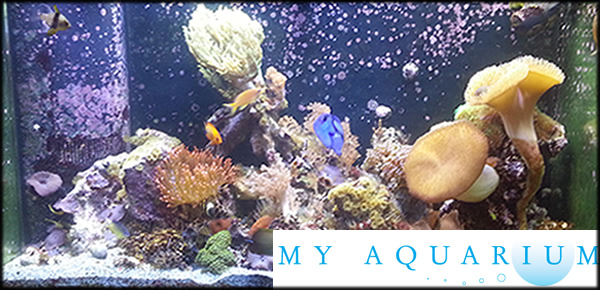Picking Out The Fish Tank That Fits Your Vision.
Many beginner aquarists start out with small aquariums, but a large aquarium is actually easier to maintain than a small one. When shopping for an aquarium for the first time it is therefore a good idea to look for fairly large ones and leave the small ones for more advanced aquarists. In a large aquarium, the larger water mass will create a more stable environment for the inhabitants and there will also be more water to dilute organic waste and other pollutants. If you as a beginner find yourself in a situation where you have to choose between filling a large aquarium with inexpensive fish or filling a small aquarium with expensive fish, you should definitely chose the first alternative. It is unfortunately quite common for beginner aquarists to stock small aquariums with costly fish only to be forced to watch them die one after another due to improper water conditions.
Volume is not the only interesting figure when purchasing an aquarium. If you plan on keeping bottom dwelling fish the bottom area can be more important than the exact volume and it can be better to go for a shallow aquarium with a large bottom area than a tall aquarium with a small bottom area. If you on the other hand plan on keeping very tall fishes, such as freshwater angelfish and discus, the height of the aquarium is more important than the volume since these fishes can become stunted in aquariums that aren’t tall enough for them.
When it comes to size it is naturally also important to check the measurements of the final destination and the vehicle you plan on transporting the tank in. Your living room or basement may be large enough to house your huge aquarium, but will you be able to fit it into your car and manoeuvre it through doors and hallways? Perhaps it is better to choose an aquarium that can be assembled onsite? Perhaps you need to arrange special transportation for your tank? Some stores (both online and local) offer home delivery, but it is important to check the fine print to find out if it will be delivered to the right part of your home or simply left outside your house.
Before buying an aquarium, it is important to calculate how heavy it will be when filled with water, substrate and aquarium decorations. An aquarium can actually cause the floor to collapse, so you have to be careful. The collapse doesn’t have to occur right away; the long-term impact of the weight on a particular spot can cause long-term damage that may not manifest until you have had your tank for a while. In addition to having a strong enough floor, you will also need a strong enough stand or aquarium furniture to place the aquarium on. Placing anything larger than 20 gallons on an ordinary table or shelf is considered risky.
Both glass aquariums and acrylic aquariums are popular within the hobby and they each come with their own advantages and drawbacks. Acrylic is stronger than glass and a better isolator, but it is also more susceptible to scratch marks. It will usually be extremely clear when new and then gradually loose its clarity as it receives more and more scratch marks. Glass is more resilient towards scratches and will therefore typically stay clear for a longer period of time, but since it is a poor isolator it will call form more potent heating. Generally speaking, acrylic aquariums are more expensive than glass aquariums.
Acrylic is rarely used for large hobbyist aquariums but is a fairly common material for small and medium sized tanks. One of the main advantages of acrylic is that it can be moulded into many different shapes, e.g. to create aquariums with rounded corners. Other benefits of acrylic are that it is light and known to withstand transportation well.
If you decide to go for a glass aquarium you will have to decide between regular glass and optical quality. Regular glass contains iron impurities which give it a blue-green tinge and can make tank inhabitants appear less colourful. The thicker the glass, the more noticeable the tinge. Optical quality glass is considerably more expensive but also much clearer than regular aquarium glass.
Things to check for
- Always check the aquarium for scratches before you make a purchase. This is especially important if you are buying an acrylic aquarium. It is however possible to repair light scratches on acrylic aquariums by buffing the marks out with metal surface polish and a rag. If this is not enough, try a really fine sand paper before proceeding to metal surface polish and rag.
- On glass aquariums, all cut glass edges should be smooth and even.
- The various parts of a glass aquarium should be joined together by an even bead of silicon. It is important to choose an aquarium where all the silicone joints are contacting well, unless you are okay with fixing this on your own before you use the tank. (Acrylic aquariums are instead bonded cohesively with a liquid that fuses the parts together.)
- Does the aquarium have a lid? Many fish species are agile jumpers and need a secure lid to prevent them from escaping from the aquarium.
- Are lights included in the aquarium lid or do you have to get a separate light fixture?


